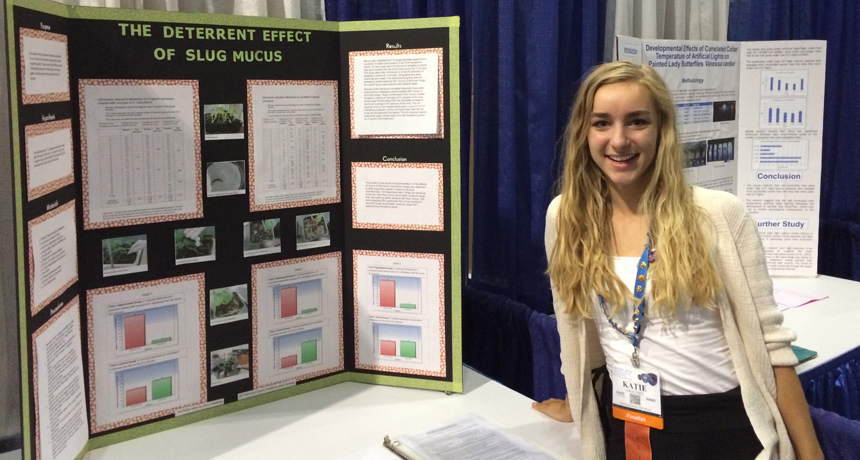Slime: A new way to protect plants from slugs

Katie Gwaltney decided to solve her garden slug problem by attacking the pests with a concoction made from slug slime.
B. Brookshire/SSP
LOS ANGELES — “In Georgia, everyone complains about the slugs,” says Katie Gwalteny. The 15-year-old freshman at Union Grove High School in McDonough, Ga., wasn’t a fan either. The slugs were chomping away on her garden plants. But she wasn’t quite sure how to stop them. “I heard about salting and egg-shelling the slugs,” she says, “but it just ends up ruining the soil and killing the slugs.” The teen wanted a more humane way to rout the pests. And she found it in the slug’s own slime.
Katie presented her findings at this week’s International Science and Engineering Fair, or ISEF. Created by Society for Science & the Public and sponsored by Intel, the 64th annual Intel ISEF showcases some of the best high school science projects from around the globe. (SSP also publishes Science News for Students and this blog).
The grey garden slug, Deroceras reticulatum, is a garden pest that appears to have migrated from Europe. It chows down on all kinds of young garden plants. In her research, Katie found these slugs are territorial. That means they try to keep other slugs away from their favorite menu items. In analyzing how they might do this, Katie hypothesized that the pests marked their territories with their slime. If true, she might be able to use that slime to deter slugs from her plants.
To test the idea, the teen collected slugs from her garden. She lured them with delicious sliced strawberries. She also purchased 50 strawberry plants, Fragaria ananassa. She divided her slugs into two groups. The first became her “resident” slugs. She let them crawl all over some filter paper, releasing their slime. Katie then rinsed off the slime, and poured the rinse water on 25 strawberry plants. The other 25 plants got plain water.
Now Katie worked with the remaining slugs. She placed one in each pot holding a strawberry plant. Watching carefully, she recorded whether a slug went towards the strawberry plant or tried to crawl away.
Strawberry plants treated with only water proved attractive. About half of the slugs headed toward this tasty snack. But if the strawberry plant had been watered with her slime juice, visiting slugs avoided the plants 95 percent of the time. They showed no desire to be around the slime of other slugs.
The results suggest that there may be a chemical scent, or pheromone, in slug slime that warns slugs to steer clear of it. Katie hopes to isolate this signaling chemical in future studies. “I’d like for it to be made into a product, a spray that could keep slugs away without killing them,” she says. For now, the teen plans to apply her homemade slug juice in her own garden this summer. She’ll be fighting slimers with slime.
Follow Eureka! Lab on Twitter
Power Words
grey garden slug (Deroceras reticulatum) A common garden pest that is originally from Europe, but has invaded other areas including North America. It feeds on fruits, seeds and plants, and is especially bad in areas where there is a lot of rain.
hypothesis A proposed explanation for a phenomenon. In science, a hypothesis is an idea that hasn’t yet been rigorously tested. Once a hypothesis has been extensively tested and is generally accepted to be the accurate explanation for an observation, it becomes a scientific theory. Ideas that are based on a hypothesis are referred to as hypothetical.
pesticide A chemical or mix of compounds used to kill insects, rodents or other organisms harmful to cultivated plants, pet or livestock, or unwanted organisms that infest homes, offices, farm buildings and other protected structures.
pheromone A molecule or specific mix of molecules that makes other members of the same species change their behavior or development. Pheromones drift through the air and send messages to other animals, saying such things as “danger” or “I’m looking for a mate.”
Fragaria ananassa The common strawberry.
territorial A word used to describe organisms that try to keep other organisms of their species away from an area they control.